What's New Under The Sun
Madison Historic Dial Returns
Monday, 13 October 2025 22:49
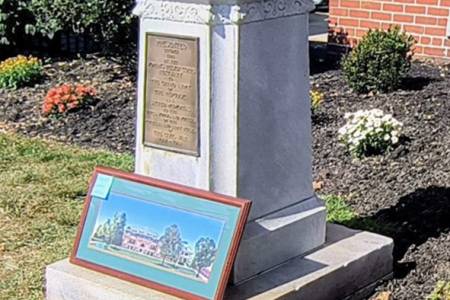 On October 4, 2025 Madison Historical Society of Ohio was able to have their sundial returned after 32 years, when in 1993 it was moved to the lawn of Lake County Courthouse to reduce the chance of vandalism. The sundial was originally placed at Madison Home 100 years ago on Saturday, October 24, 1925 during a conference of the Women's Relief Society. From 1904 to 1962 the state ran this...
On October 4, 2025 Madison Historical Society of Ohio was able to have their sundial returned after 32 years, when in 1993 it was moved to the lawn of Lake County Courthouse to reduce the chance of vandalism. The sundial was originally placed at Madison Home 100 years ago on Saturday, October 24, 1925 during a conference of the Women's Relief Society. From 1904 to 1962 the state ran this...
Elements of Dialing Course - 2025
Monday, 15 September 2025 19:42
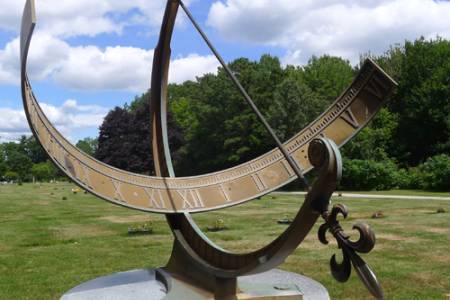 NASS is pleased to announce the upcoming fifth instance of Elements of Dialing, our introductory course about sundials, their history, and the science that makes them work. The free 12-lesson course, intended for those are new to sundialing, runs from 27 October 2025 until 26 April 2026. The course instructor is Robert Kellogg, NASS Vice President and Sundial Registrar. Bob will be...
NASS is pleased to announce the upcoming fifth instance of Elements of Dialing, our introductory course about sundials, their history, and the science that makes them work. The free 12-lesson course, intended for those are new to sundialing, runs from 27 October 2025 until 26 April 2026. The course instructor is Robert Kellogg, NASS Vice President and Sundial Registrar. Bob will be...
Sun Queen of World War II
Thursday, 11 September 2025 23:11
 A Hungarian born American scientist, Mária Telkes (1900-1995), was called "The Sun Queen" and among other honors, was postmousthly inducted into the National Inventors Hall of Fame. She lived to 95 and for most of her life developed solar power in a variety of forms.
Trained as a biophysicist, she worked for Westinghouse Electrical and Manufacturing Company in Pittsburgh, PA, where she...
A Hungarian born American scientist, Mária Telkes (1900-1995), was called "The Sun Queen" and among other honors, was postmousthly inducted into the National Inventors Hall of Fame. She lived to 95 and for most of her life developed solar power in a variety of forms.
Trained as a biophysicist, she worked for Westinghouse Electrical and Manufacturing Company in Pittsburgh, PA, where she...
2025 Conference -Ottawa
Thursday, 28 August 2025 23:25
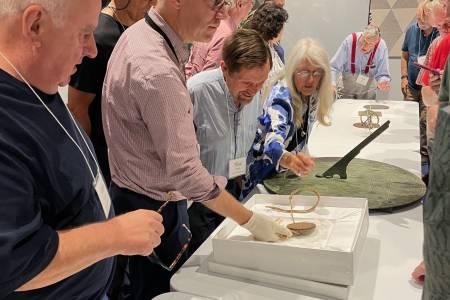 The annual NASS Conference was held 7-10 August, 2025 in Ottawa. As usual, the conference began late Thursday afternoon with an introduction social and a "grab bag give away", taking your chances with tickets to win the bag's prize. Will Grant was the final winner of the Walton Double Planar Polar Sundial, but Paul Ulbrich beat the statistic odds and won this prize three times,...
The annual NASS Conference was held 7-10 August, 2025 in Ottawa. As usual, the conference began late Thursday afternoon with an introduction social and a "grab bag give away", taking your chances with tickets to win the bag's prize. Will Grant was the final winner of the Walton Double Planar Polar Sundial, but Paul Ulbrich beat the statistic odds and won this prize three times,...
Prosciutto di Portici Sundial's Owner
Tuesday, 10 June 2025 18:51
 Prosciutto di Portici (Ham) Sundial
Photo: Getty Images
The Prosciutto di Portici Sundial, more often called the Portici Ham Sundial, dates from the first century somewhere between 8 BCE to 79 CE. This small silvered bronze dial was uncovered on 11 June, 1755 in the ruins of Herculaneum (current day Portici) in the "Villa of the Papyri", buried in...
Prosciutto di Portici (Ham) Sundial
Photo: Getty Images
The Prosciutto di Portici Sundial, more often called the Portici Ham Sundial, dates from the first century somewhere between 8 BCE to 79 CE. This small silvered bronze dial was uncovered on 11 June, 1755 in the ruins of Herculaneum (current day Portici) in the "Villa of the Papyri", buried in...
Hamilton Dial Dedicated
Friday, 06 June 2025 21:01
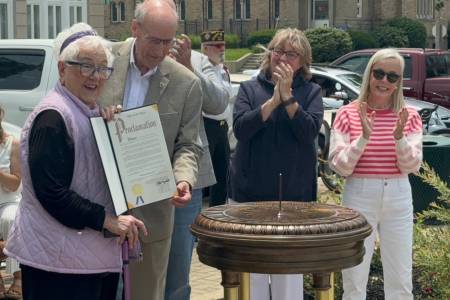 Sundial dedication May 31, 2025. At left is Kathleen Stuckey Fox, with the City Proclamation presented by Mayor Pat Moeller and City Council on-lookers Carla Fiehrer and Susan Vaughn offering congratulations.
On May 31, 2025 at 1pm, the Hamilton, Ohio, sundial (NASS Sundial Registry #1109) was re-dedicated in Monument Park. Originally dedicated in 1941 to the...
Sundial dedication May 31, 2025. At left is Kathleen Stuckey Fox, with the City Proclamation presented by Mayor Pat Moeller and City Council on-lookers Carla Fiehrer and Susan Vaughn offering congratulations.
On May 31, 2025 at 1pm, the Hamilton, Ohio, sundial (NASS Sundial Registry #1109) was re-dedicated in Monument Park. Originally dedicated in 1941 to the...
Frans Maes Received a Royal Decoration
Monday, 24 March 2025 21:33
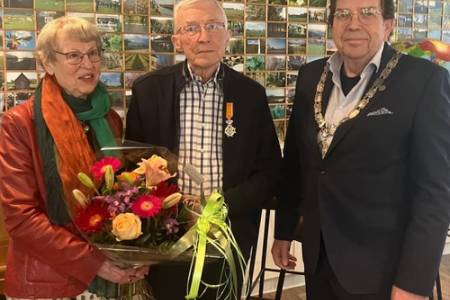 Several years ago Frans decided to write the course on sundials that included self assessment questions to force students not only to read the text, but to internalize the concepts. And a final submittal question "not necessarily a difficult question, but: no answer, no new lesson." Thus Frans Maes began writing lessons and sending them out to students.
NASS has now used his material to create...
Several years ago Frans decided to write the course on sundials that included self assessment questions to force students not only to read the text, but to internalize the concepts. And a final submittal question "not necessarily a difficult question, but: no answer, no new lesson." Thus Frans Maes began writing lessons and sending them out to students.
NASS has now used his material to create...
Pros and Cons of Daylight Savings Time
Monday, 24 March 2025 15:37
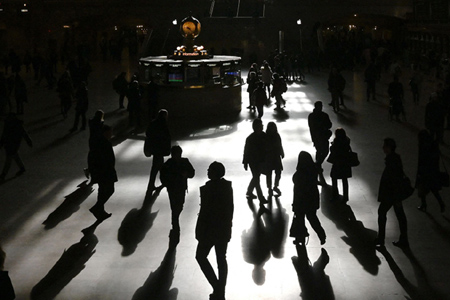 In a 24 March 2025 article from the on-line Science Advisor (American Association for the Advancement of Science) Phie Jacobs summarizes the "great debate" of the yearly shift from standard time to daylight savings time. In January 2025 the US Senate introduced the Sunshine Protection Act to permanently have daylight savings time year round. Certainly 54% of Americans do not like the...
In a 24 March 2025 article from the on-line Science Advisor (American Association for the Advancement of Science) Phie Jacobs summarizes the "great debate" of the yearly shift from standard time to daylight savings time. In January 2025 the US Senate introduced the Sunshine Protection Act to permanently have daylight savings time year round. Certainly 54% of Americans do not like the...
Native American Moon Alignment Ring
Friday, 21 March 2025 19:26
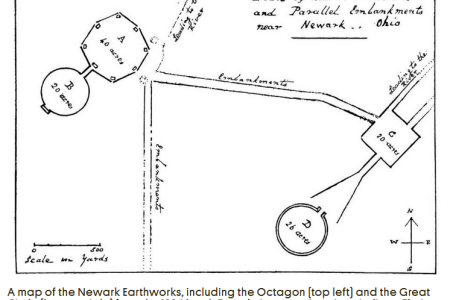 Perhaps the most famous alignment circle in the United States is the Cahokia Woodhenge near St. Louis constructed between 700-1400 CE by Cahokia Indigenous native Americans. But there were an estimated 10,000 other earthen mounds that once were scatter across the mid-west..
In an article from Atlas Obscura (https://www.atlasobscura.com/articles/octagon-earthworks-ohio) by Olivia Young on March...
Perhaps the most famous alignment circle in the United States is the Cahokia Woodhenge near St. Louis constructed between 700-1400 CE by Cahokia Indigenous native Americans. But there were an estimated 10,000 other earthen mounds that once were scatter across the mid-west..
In an article from Atlas Obscura (https://www.atlasobscura.com/articles/octagon-earthworks-ohio) by Olivia Young on March...
Hamilton Dial under Restoration
Friday, 21 March 2025 18:37
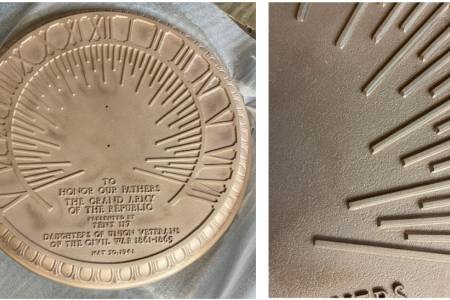 The Hamilton dial is in the restorative care of Jarrett and Celene Hawkins (Hawkins & Hawkins Custom, LLC in Cincinnati Ohio https://www.studio-hawkins.com/) in preparation for the dial's dedication on Saturday, May 31, 2025.
The face of the Hamilton Grand Army of the Republic (GAR) sundial has been cleaned and bead-blasted showing the dial as it was cast 84 years ago. In the process,...
The Hamilton dial is in the restorative care of Jarrett and Celene Hawkins (Hawkins & Hawkins Custom, LLC in Cincinnati Ohio https://www.studio-hawkins.com/) in preparation for the dial's dedication on Saturday, May 31, 2025.
The face of the Hamilton Grand Army of the Republic (GAR) sundial has been cleaned and bead-blasted showing the dial as it was cast 84 years ago. In the process,...
VSSC Space Museum gets Polar Sundial
Tuesday, 17 December 2024 23:47
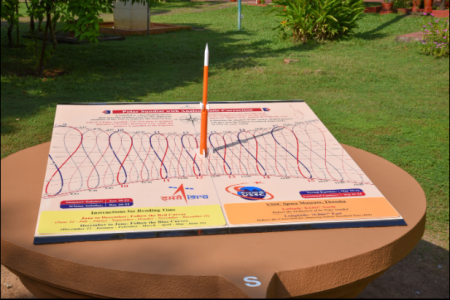 In November 2024, a team consisting of members from SPL, TTDG and CMD of VSSC successfully designed and installed an accurate and fully functional sundial at the Rocket Garden of VSSC Space Museum, Thumba (8.53°N, 76.86°E). Following a space theme, the vertical gnomon is a 3-stage rocket that casts its daily and seasonal shadow on a dial face 1 1/2 meters by 1 meter. The the sundial face...
In November 2024, a team consisting of members from SPL, TTDG and CMD of VSSC successfully designed and installed an accurate and fully functional sundial at the Rocket Garden of VSSC Space Museum, Thumba (8.53°N, 76.86°E). Following a space theme, the vertical gnomon is a 3-stage rocket that casts its daily and seasonal shadow on a dial face 1 1/2 meters by 1 meter. The the sundial face...
Historic Sundials of Andalusia
Saturday, 16 November 2024 00:07
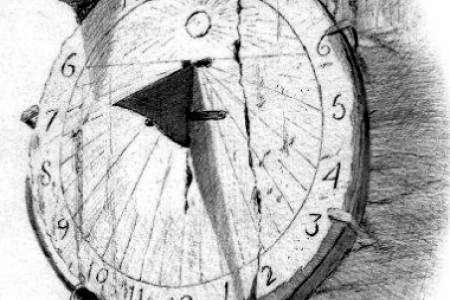 Esteban Martínez Almirón has published a new book Historical Sundials: Forgotten Andalusian Treasures (Relojes de Sol Históricos Tesoros Andaluces Olvidados) In it he reviews over 400 sundials from the Andalucian region of southern Spain Originally to celebrate the 25th year of the website https://relojandalusi.org/
Esteban Martínez Almirón began showing his sundial drawings on the site....
Esteban Martínez Almirón has published a new book Historical Sundials: Forgotten Andalusian Treasures (Relojes de Sol Históricos Tesoros Andaluces Olvidados) In it he reviews over 400 sundials from the Andalucian region of southern Spain Originally to celebrate the 25th year of the website https://relojandalusi.org/
Esteban Martínez Almirón began showing his sundial drawings on the site....
Getty Research Institute on the Solstice
- Details
- Hits: 4335
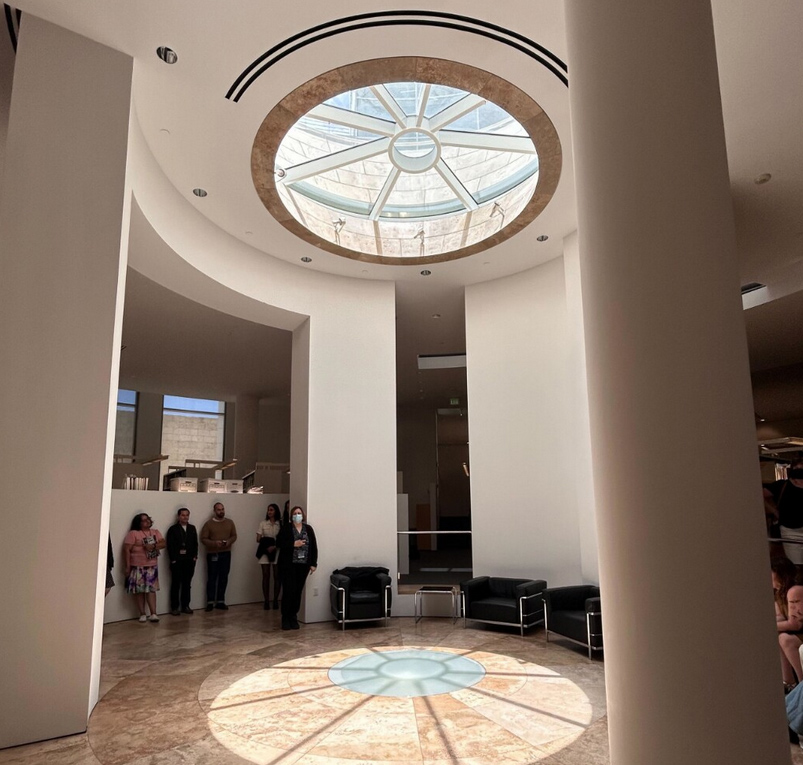 Off Interstate 405 in the hills of Los Angeles is the Getty Research Institute, part of the campus of The Getty Center. The Center houses the free Getty Museum, the Getty Library, Getty Research Institute, Getty Foundation, and Getty Conservation Institute. The Getty Research Institute opened its doors to the public in December of 1997, where besides the thousands of books, art collections, and photos, architect Richard Meier designed a wonderful solar alignment. In the center of the circular building is large, round, glass-framed oculus that acts as a skylight for the library gallery floor beneath. But the oculus skylight is not centered on the vertical. Instead, the glass framework is angled to accommodate the institute's latitude of 34.077° North. Some simple map shows that the oculus framework needed be angled 10.637° south from the vertical. At this angle at local solar noon on the day of the solstice, the oculus casts a circular shadow centered on the library's marble floor beneath. Photo from Getty Research Institute, Creative Commons.
Off Interstate 405 in the hills of Los Angeles is the Getty Research Institute, part of the campus of The Getty Center. The Center houses the free Getty Museum, the Getty Library, Getty Research Institute, Getty Foundation, and Getty Conservation Institute. The Getty Research Institute opened its doors to the public in December of 1997, where besides the thousands of books, art collections, and photos, architect Richard Meier designed a wonderful solar alignment. In the center of the circular building is large, round, glass-framed oculus that acts as a skylight for the library gallery floor beneath. But the oculus skylight is not centered on the vertical. Instead, the glass framework is angled to accommodate the institute's latitude of 34.077° North. Some simple map shows that the oculus framework needed be angled 10.637° south from the vertical. At this angle at local solar noon on the day of the solstice, the oculus casts a circular shadow centered on the library's marble floor beneath. Photo from Getty Research Institute, Creative Commons.
Read more at: https://www.getty.edu/news/summer-solstice-at-the-research-library/
Preparing for the Solar Eclipse of April 8th 2024
- Details
- Hits: 6711
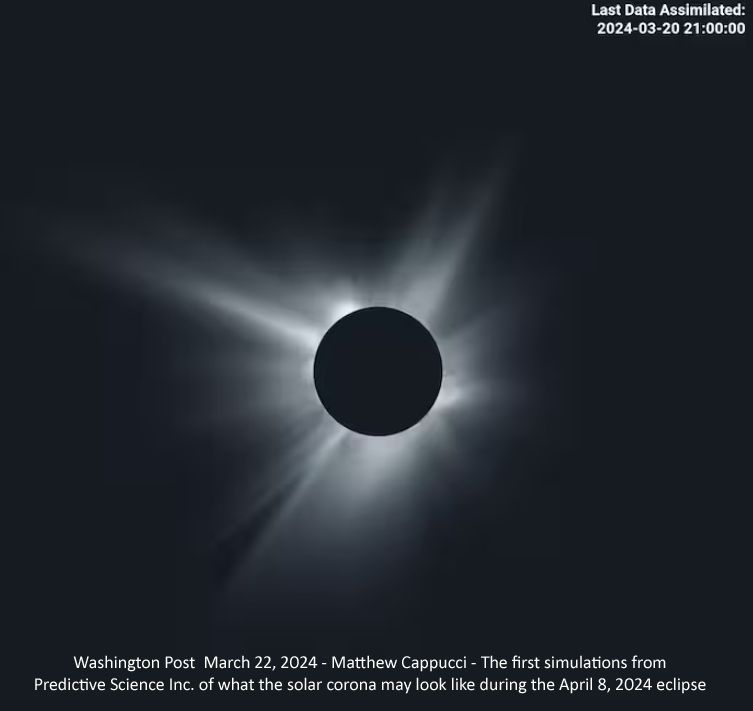 There are lots of maps showing where to go for the April 8th 2024 total solar eclipse and others showing the statistical chance of clouds such as https://www.washingtonpost.com/weather/2024/02/22/april-eclipse-clouds/ From Little Rock Arkansas to the Mazatlan coast there is a high probability of clear weather. The cities from Indianapolis through Cleveland OH, Rochester and Syracuse NY and Burlington VT have a good chance of cloud cover. Fortunately such websites as Time and Date https://www.timeanddate.com/live/eclipse-solar-2024-april-8 will live-stream the eclipse with totality beginning 12:38pm EDT and on YouTube Through the Eyes of NASA - Official Broadcast at https://www.youtube.com/watch?v=2MJY_ptQW1o
There are lots of maps showing where to go for the April 8th 2024 total solar eclipse and others showing the statistical chance of clouds such as https://www.washingtonpost.com/weather/2024/02/22/april-eclipse-clouds/ From Little Rock Arkansas to the Mazatlan coast there is a high probability of clear weather. The cities from Indianapolis through Cleveland OH, Rochester and Syracuse NY and Burlington VT have a good chance of cloud cover. Fortunately such websites as Time and Date https://www.timeanddate.com/live/eclipse-solar-2024-april-8 will live-stream the eclipse with totality beginning 12:38pm EDT and on YouTube Through the Eyes of NASA - Official Broadcast at https://www.youtube.com/watch?v=2MJY_ptQW1o
But what will you see during totality when you can take off your solar protective glasses? Predictive Sciences Inc, funded by NASA and the National Science Foundation (NSF) have created a " Data-Assimilative, Continuously Running Prediction Model Updated in Near Real Time" showing what the solar corona may look like during totality. The prediction is based on the current state of sunspots, solar flares, corona mass ejections, and the sun's magnetic field.See it at: https://www.predsci.com/corona/apr2024eclipse/home.php
The corona is expected to be much more active and extensive than the total eclipse that crossed the United States in August 2017 as the sun isnow approaching sunspot maximum
Today - Chicagohenge
- Details
- Hits: 8725
The date is Sep. 22, 2022, the date of the fall equinox. Although this is supposed to be the day of equal day and night, we know it's not exactly correct. We measure daytime from sunrise to sunset, measured as the first and last light from the sun peaking over the horizon. When we include sunrise and sunset plus atmospheric refration, at mid latitudes daylight wins by about 10 minutes (not even counting twilight).
 Chicagohenge photo by Tim Hara
|
But something magical happens as the sun sets due west on the equinox in Chicago. The sunset direction matches the direction of the Chicago grid of East-West streets. The effect is known as Chicagohenge.
From the Adler Planetarium website (https://www.adlerplanetarium.org/blog/chicagohenge/): "Chicagohenge occurs twice a year and happens when the Sun directly lines up with Chicago’s east-west facing streets ... To fully understand Chicagohenge, you have to be aware of the two main factors that cause it: Chicago’s grid plan and equinoxes...The present-day Chicago grid system can be attributed to the Public Land Survey System -- a surveying method created in 1785 that was used to divide land for selling and settling. But this style of city design has been around since the dawn of civilization and can be found in the ruins of ancient Rome, Greece, and others [sometimes creating solar alignments in these cities such as Manhattan Henge] ... Fun fact: Chicago’s streets line up almost perfectly with the cardinal east and west directions on a compass. This in turn, sets up the perfect stage for Chicagohenge to take place."
The Planetarium Blog continues. "Since the Earth’s axis is tilted, sunlight is not always distributed equally. At any given point, one-half of the Earth is tilted towards the Sun more than the other. As the Earth orbits around the Sun, the part that was tilting away from the Sun begins to be the part that is facing towards the Sun. This is why we have seasons! ... There are two equinoxes each year, one that marks the start of spring (Spring Equinox) and one that marks the end of summer (Autumn Equinox). Thanks to Chicago’s perfectly lined grid system, the bi-annual equinoxes mark a time when the Sun rises and sets directly in line with Chicago’s east and west streets, causing Chicagohenge! ... Finding a place to spot Chicagohenge is a no-brainer! Simply find one of Chicago’s east-west facing streets, plop a seat, and enjoy the view."
Eclipse of Sun by Phobos Seen by Perseverance Rover
- Details
- Hits: 7043
 On April 2, 2022 the Perseverance Martian rover's Mastcam-Z camera looked sunward and took a video of the eclipse of the sun by the "potato-shaped" moon Phobos.
On April 2, 2022 the Perseverance Martian rover's Mastcam-Z camera looked sunward and took a video of the eclipse of the sun by the "potato-shaped" moon Phobos.
According the NASA Mars Exploration Program site, "It’s the most zoomed-in, highest-frame-rate observation of a Phobos solar eclipse ever taken from the Martian surface." NASA reports that "Several Mars rovers have observed Phobos crossing in front of the Sun over the past 18 years. Spirit and Opportunity made the first observations in 2004; Curiosity in 2019 was the first to record video of the event. Each time these eclipses are observed, they allow scientists to measure subtle shifts in Phobos’ orbit over time. The moon’s tidal forces pull on the deep interior crust and mantle of the Red Planet; studying how much Phobos shifts over time reveals something about how resistant the crust and mantle are, and thus what kinds of materials they’re made of."
Watch the video: https://mars.nasa.gov/news/9172/nasas-perseverance-rover-captures-video-of-solar-eclipse-on-mars/
Art Project: "Unit of Measurement"
- Details
- Hits: 18572
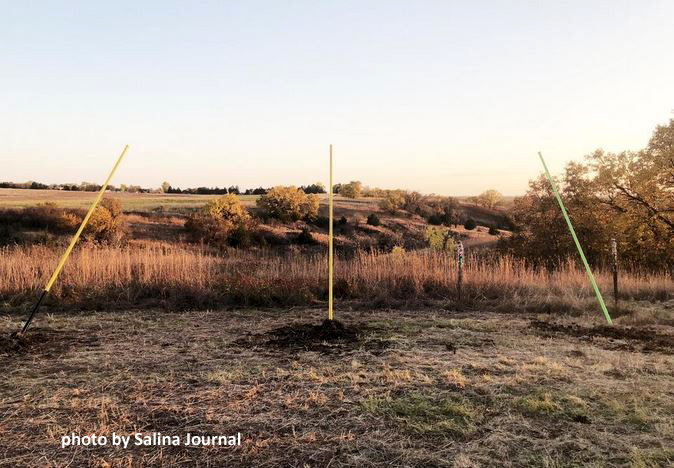 The Land Institute is a not for profit organization based in Salina, Kansas, having a goal to create an agriculture system that mimics natural systems in order to produce ample food and reduce or eliminate the negative impacts of industrial agriculture. A mile north of the Institue is their Marty Bender Nature Area where Owen Brown has created an art project "Units of Measurement". According to Jason Beets of the Salina Journal, his project "consists of three sets of sun dials created from praire-colored angled flag poles to symbolically represent the passage of time."
The Land Institute is a not for profit organization based in Salina, Kansas, having a goal to create an agriculture system that mimics natural systems in order to produce ample food and reduce or eliminate the negative impacts of industrial agriculture. A mile north of the Institue is their Marty Bender Nature Area where Owen Brown has created an art project "Units of Measurement". According to Jason Beets of the Salina Journal, his project "consists of three sets of sun dials created from praire-colored angled flag poles to symbolically represent the passage of time."
The idea is to meditate on the passage of time. The first set of three poles, called "In the Beginning" is 1,190 feet east of another set of poles called "The Passage of a Second". According to the artiist, this is the distance that the earthrotates in one second. A third site, called "From the Future" is located 723 feet north of "In the Beginning" is placed such that at "... dawn of the summer solstice, the shadows of the sundials at “From the Future” will touch [point to] the sundials at “The Passage of a Second.” Owen said, "I want this installation to make us more aware of where we are, who we are, and how we are ... in relation to the earth, to what we grow, and to what nurtures us."
Interesting art but very poor science. For each cluster of three flag poles, only the one point to North can work as a sundial. And the pole needs to be at an angle from the ground equal to the latitude of 38.855° N. From the photo, the angle is closer to 60°. Fortunately there are no hour lines on the ground to show the incorrect time of the shadow.
Updated Content: 28 Feb 2022
We've recomputed "The Passage of a Second" using Earth Centered Earth Fixed (ECEF) coordinates for the latitude of 38.855° N and an altitude of 1,227 ft attributed to Salinas, KS. The result is an earth radius of 4.973775 x 10^6 meters giving a circumference of 31,251.15km. But to count exactly one revolution of the earth (in inertial space) we need to use the sidereal day of 86164.1 sec rather than the mean solar day of 86400 sec. And just as Owen Brown has separated "In the Beginning" and "The Passage of a Second", the distance is 1190 feet. The angle from east of "From the Future" 723 feet north of "In the Beginning" as seen from "The Passage of a Second" is 31.28° or 121.28° from south. The first rays of the sun appear on the eastern horizon when the center of the sun is actually 0.833° below the horizon. The sun's apparent position is due in part to atmospheric refraction. Taking this effect into account, sunrise on the summer solstice will occur at an azimuth from south of 121.3°, the alignment used by Owen Brown.
Indeed the sunlight is coming from the future on the solstice, traveling the Pythagorean distance of 1,392.4 feet in (424.4m) between Future and Passage requires 1.4 microsecond. Owen Brown's simple constructs with precision placement is something to be contemplated.
Read more at: http://www.salina.com/news/20181027/land-institute-art-project-reflects-on-time-nature
Cosmic Room on the Equinox - 2018
- Details
- Hits: 12840
The heart of the Cosmic Room is an unusual vertical meridian sundial created by sunlight passing through a slot on the roof above. In winter the solar meridian transit is labeled with a column of blue tiles and at the spring equinox the tiles change to orange. The sign "Analemma 12:45" indicates civil time on the spring equinox when the sun is on the local meridian. With the sun overhead, the beam of light follows the vertical set of tiles downward until it reaches the boundary between orange and blue tiles - the equinox has arrived. Ruben Nohitol has been photographing this event for the last 16 years, every year since 2002. From a ceiling hole Ruben marks the image of the sun at 12:45 on the floor with a small green circle. He does this on dates throughout the year(s), not only creating a nice analemma, but does it with such precision that he is able to notice the slight shifts in solar equinox position through the leap year cycle of four years.
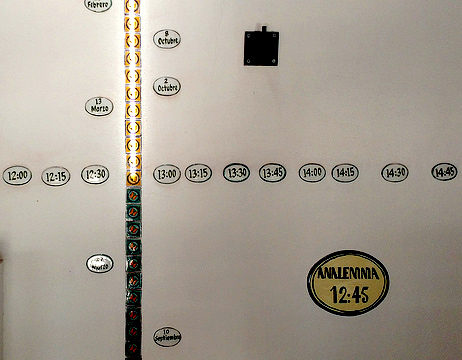
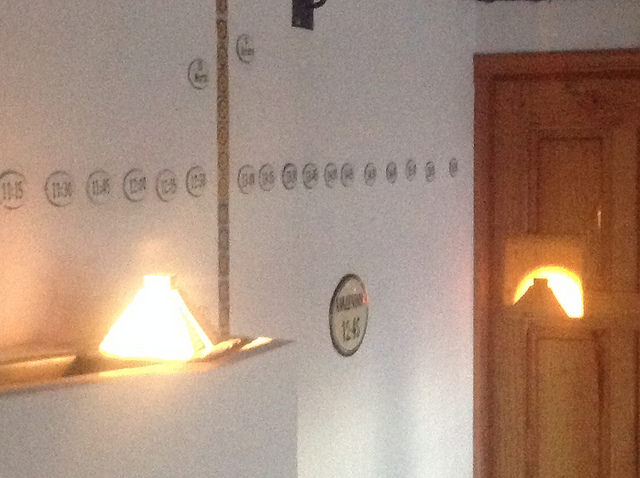
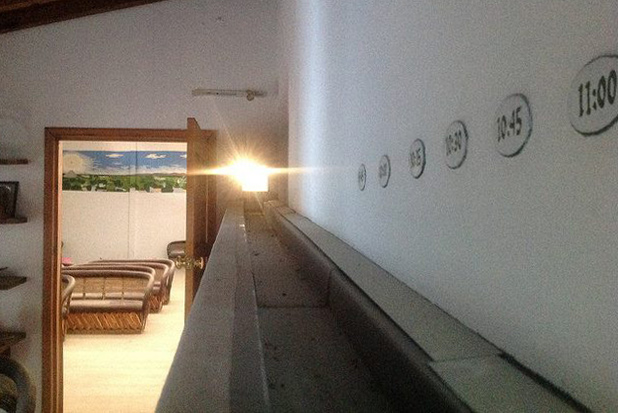 More impressive is the due west sunset on the equinox. A beam of light streams though a hole in the western wall of his hacienda, across the living room, through a square hole between rooms, across the Cosmic Room grazing past the vertical sundial and its tiles, and lands as a bright solar disk at the far end of the Cosmic Room on a vertical wood screen mounted on an exit doorway. To add to the drama of the setting equinox sun, Ruben placed a model of the pyramid of El Cerrito on a shelf in the Cosmic Room blocking some of the sun's rays. The result is a shadow of the the pyramid against the solar disk, giving the illusion of thesun setting over the great pyramid. You can see his vertical meridian and more at http://www.makeaholeinthewall.com and the sundial in operation at http://www.sundials.org/index.php/dial-links/videos/meridiane See his patience to photograph the real setting sun over the pyramid of El Cerrito in Queretaro, Mexico at http://www.sundials.org/index.php/dial-links/videos/analemmas-time-and-motion
More impressive is the due west sunset on the equinox. A beam of light streams though a hole in the western wall of his hacienda, across the living room, through a square hole between rooms, across the Cosmic Room grazing past the vertical sundial and its tiles, and lands as a bright solar disk at the far end of the Cosmic Room on a vertical wood screen mounted on an exit doorway. To add to the drama of the setting equinox sun, Ruben placed a model of the pyramid of El Cerrito on a shelf in the Cosmic Room blocking some of the sun's rays. The result is a shadow of the the pyramid against the solar disk, giving the illusion of thesun setting over the great pyramid. You can see his vertical meridian and more at http://www.makeaholeinthewall.com and the sundial in operation at http://www.sundials.org/index.php/dial-links/videos/meridiane See his patience to photograph the real setting sun over the pyramid of El Cerrito in Queretaro, Mexico at http://www.sundials.org/index.php/dial-links/videos/analemmas-time-and-motion
Cosmic Room with Solar Analemma
- Details
- Hits: 15885
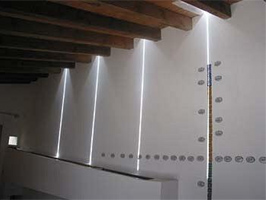
[photo courtesy of Ruben Nohuitol]
|
Ruben Nohuitol of Queretaro, Mexico has a unique solarium or “cosmic room” to observe the rays of the sun throughout the year. He has patiently constructed a wonderful time-lapse video following the sun every day at 12:45 pm. His construction has a vertical meridiana beam of light descending and then ascending the wall as time passes throughout the year. A second sky-light gnomon creates a classical analemma on the floor.
Pros and Cons of Daylight Savings Time
- Details
- Hits: 3601
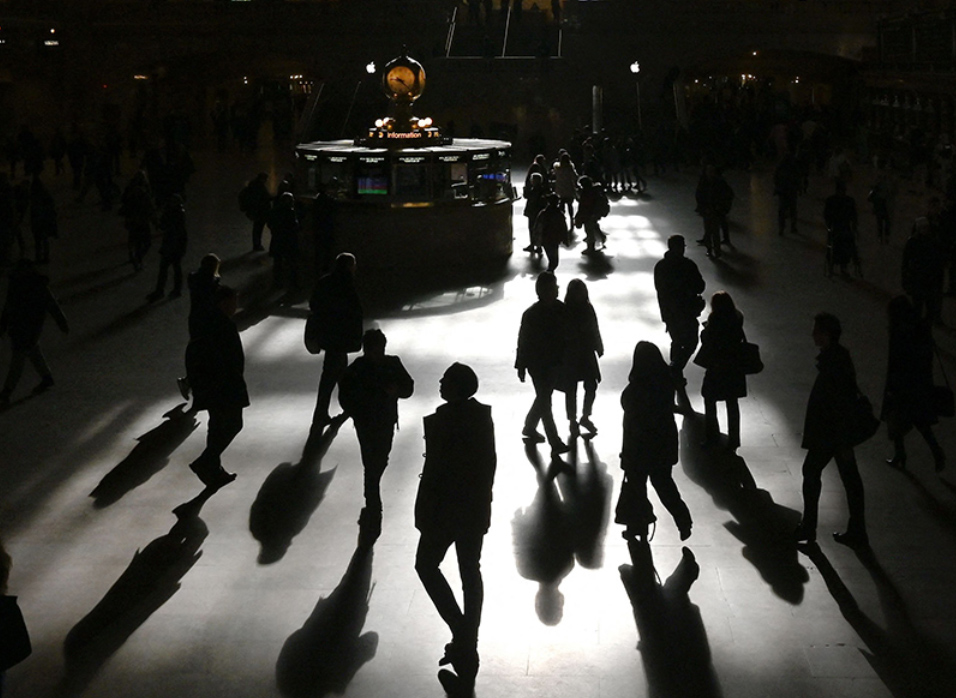 In a 24 March 2025 article from the on-line Science Advisor (American Association for the Advancement of Science) Phie Jacobs summarizes the "great debate" of the yearly shift from standard time to daylight savings time. In January 2025 the US Senate introduced the Sunshine Protection Act to permanently have daylight savings time year round. Certainly 54% of Americans do not like the annual migration from standard to savings time and back. In the US, daylight savings time was instituted in 1918 during World War I.
In a 24 March 2025 article from the on-line Science Advisor (American Association for the Advancement of Science) Phie Jacobs summarizes the "great debate" of the yearly shift from standard time to daylight savings time. In January 2025 the US Senate introduced the Sunshine Protection Act to permanently have daylight savings time year round. Certainly 54% of Americans do not like the annual migration from standard to savings time and back. In the US, daylight savings time was instituted in 1918 during World War I.
"José María Martín-Olalla, a physicist at the University of Seville and lead author of the new position paper, argues that seasonal clock changes also represent a practical solution to a broader problem: reconciling the fixed, clock-driven schedule of modern life with sunrise times that vary throughout the year."
Jacobs points out that numerous studies have linked time-related sleep disruptions to increases in heart attacks, strokes, traffic accidents, and workplace injuries, and sleep researchers strongly oppose that idea on the basis that extra-dark mornings and extra-bright evenings would dangerously disrupt people’s sleep. Many medical and scientific organizations instead advocate for permanent standard time.
Jacobs sees a middle point, saying that according to Fong-Isariyawongse, human biology functions according to light exposure and people’s circadian rhythms already naturally adjust throughout the year. “Instead of manipulating clocks,” she says, “a better approach would be to allow workplaces and schools more flexibility in adapting schedules based on natural light conditions.”
There is no easy solution. Maybe the middle ages had it right using unequal time.
Read the full article at: https://www.science.org/content/article/scientists-weigh-pros-and-cons-daylight-saving-time
Photo credit: Timothy A. Clary/AFP via Getty Images
Moon Time Using an Analemmatic Sundial
- Details
- Hits: 8357
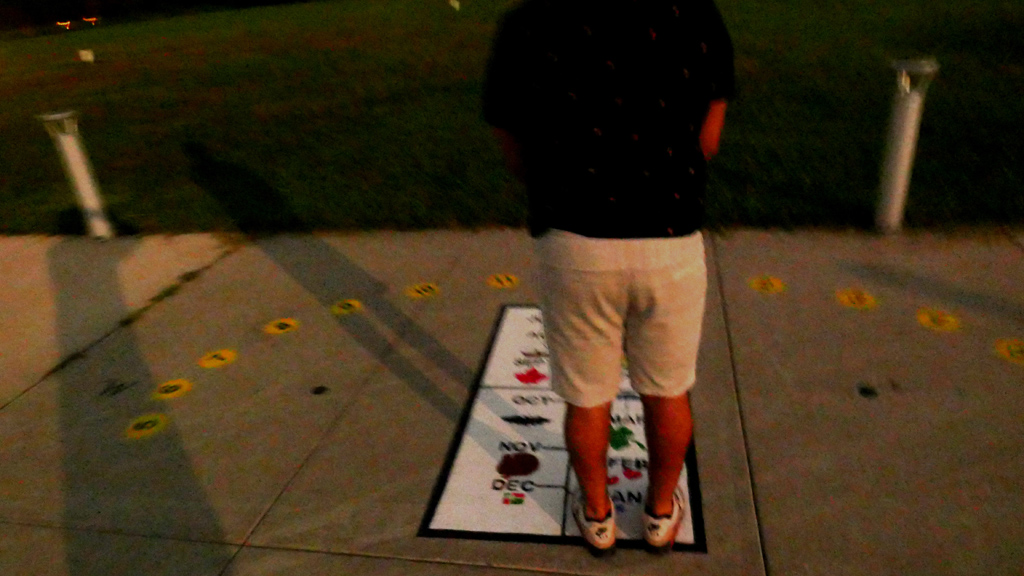 By the Light of the Moon
Photo by Dr. Jeff Kretsch
|
The analemmatic (human) sundial at Turner Farm Observatory Park in Great Falls, VA made by Eagle Scout candidate Kenny Dieffenderfer and Troop 1547 marked a unique place in sundialing history this July 23rd. The Analemma Society sponsors free Friday night public viewing of the heavens through telescopes at Turner Farm's Roll-Top Observatory. But just outside the Observatory on the sidewalk is Kenny's analemmatic dial. Could this dial tell correct time by the light of the moon?
On July 23rd this question was put to the test. It was almost exactly a full moon and the sky was clear. As can be seen in the accompanying photo taken by Dr. Jeff Kretsch at approximately 10:10pm EDT, the lunar shadow of a volunteer human gnomon cast a shadow of about 9:10pm standard moon civil time. How did this come about?
The important facts needed to make the analemmatic dial tell the correct "moon time" is knowing both the phase of the moon and the declination of the moon. On that night the moon was very close to being exactly a full moon and the declination of the moon was 25 degrees south of the equator. The maximum that the sun ever gets is 23.45 degrees south of the equator at the winter solstice. That means that (with practical precision) even though it was a late July night, the human gnomon must stand on the dial's zodiac walkway at the Dec-Jan winter solstice mark.
If this were the sun, we apply a plus 8 minute correction for the 77 deg west longitude of the observatory. The moon gets the same treatment. But what about the moon's phase and the "equation of time"? Here we find a fortunate coincidence: The moon was full moon at 10:37pm EDT on that Friday night, so by luck the moon was almost exactly opposite the sun. The moon's average full moon to full moon (a synodic month) is 29.53 days. Thus the average moon's lead or lag of a mythical full moon is about 49 minutes per day. Therefore the lunar phase correction is approximately 49 x 20/1440 = 0.68 minutes (41 seconds) ahead of the average full moon. Finally the sun's EOT for Friday July 23rd is approximately 6min 30 sec to be added to a dial's shadow to get civil time. But the moon opposite the sun has EOT in the opposite direction of minus 6min 30 sec. The net lunar correction is therefore +8.0 -.68 -6.5 = 50 sec, just less than one minute that needs to be added to that night's observation analemmatic shadow. One might say that the moon and sun were in perfect alignment!
Site Search
Sundial Question?
Current Sun
Civil = Sundial + EoT + dLon
where dLon is (4xNr Degrees W. of Time Zone
Select Sundials by State/Province
Who's Online
We have 414 guests and no members online
